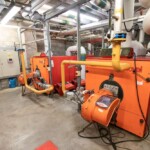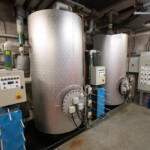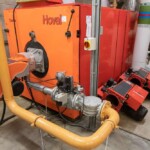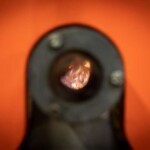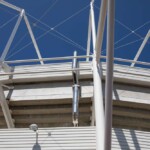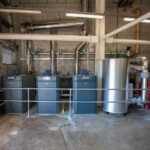The Swansea.com Stadium has had a number of energy improvements implemented over the last few years thanks to mechanical, electrical installation and maintenance specialists AMROC Group.
AMROC, a Swansea business with high-profile clients throughout the UK, has been working with the Swans to upgrade and improve the heating systems at the stadium as Richard Carlson, Project Manager of AMROC explained:
“The Swans have a complex network of systems that heat the stadium, including the under-soil heating of the pitch, the hot water for the entire stadium as well as a multi-zone central heating system that warms the hospitality boxes, function rooms, reception areas and player changing facilities.”
Opened in 2005, some of the pipework and systems in the stadium are almost 20 years old, however, as experts in retrofitting, AMROC were able to upgrade specific appliances to make them more energy-efficient without having to rip out and replace the entire network.
“Keeping a venue of this size warm can be costly, however, one of the first exercises we did when working with the stadium management team was to identify where we could make improvements that would save the club money in the long run while being relatively quick to install in the short term,” reflected Richard.
A great example of this was the burner upgrade to the two principal boilers that heat the water in the stadium.
“The older burners were very much an ‘on-off’ system, “said Richard,” “so when the stadium needed hot water, the burners went on full power and were switched off when the stadium was not in use.”
This meant that the boilers were always working at near maximum capacity to heat the water, using huge amounts of gas and, ultimately, costing a lot.
By installing a modulated burner system, the boilers not only integrated with the stadium’s Building Management System (BMS) to monitor and remotely control the heat levels, but the sensors monitored the flow temperature of the boilers.
Rather than heating from cold each time, the modulated burners fire up when the water temperature drops below a certain point, thus keeping the water at a consistent “warmth”. This not only uses less gas, so reduces the bills, but the quality of the burners means they are on for shorter periods of time when in use, using even less gas.
In addition to the burners, the AMROC team also overhauled the old floor-standing boilers that were powering the undersoil heating, and running at 75% inefficiency.
“Boiler technology has come on leaps and bounds since the original ones were installed,” said Richard, “so we replaced the floor-standing ones with three, highly-efficient condensing appliances which not only keep the pitch warm but if one boiler goes down, there is a standby option ready to fire up.
And with significant financial penalties from the EFL, if the Swans were unable to fulfil a fixture due to a frozen pitch, under-soil heating is a must.
“The new boilers fill a 1,000-litre vessel and keep the water at a set temperature to gently warm the pitch without damaging the grass,” he said. “And thanks to our ability to retrofit, we were able to connect the new boilers to the majority of the old pipework, keeping disruption to a minimum.”
Thanks to the new sensors installed, the digital plant room can monitor external thermal conditions and fire up the system as and when required, making sure that no matter the weather, the Swans will have an ice-free pitch.

